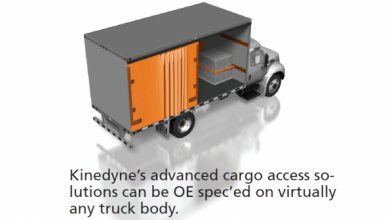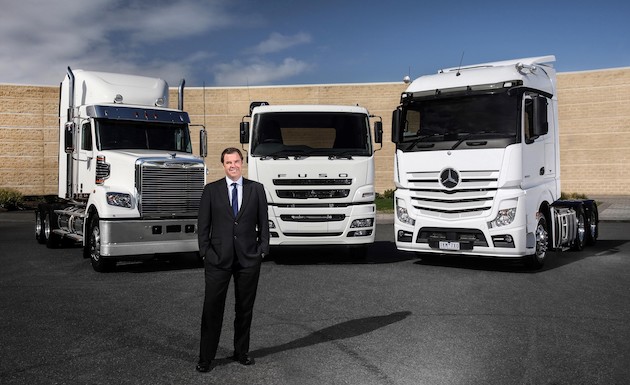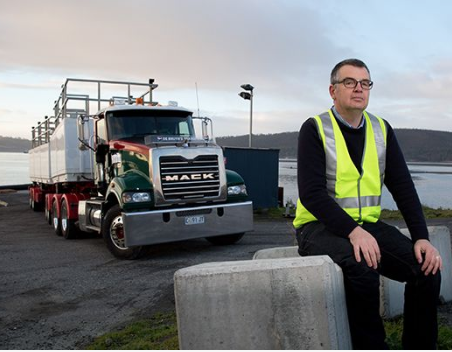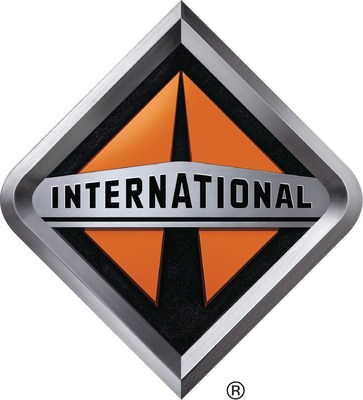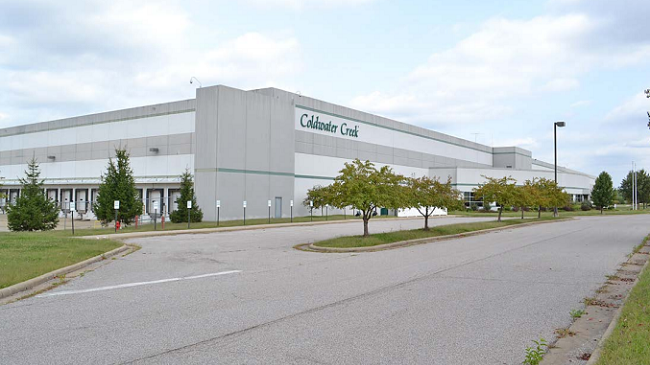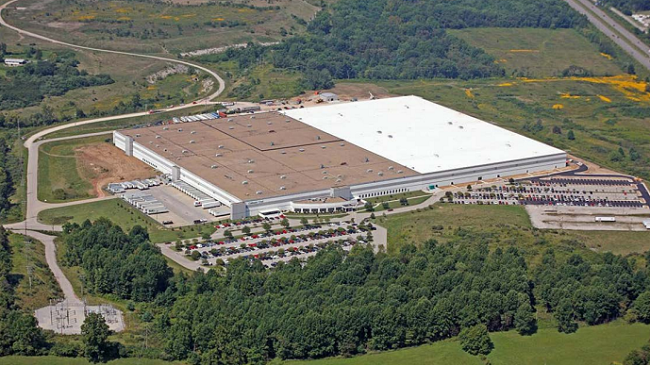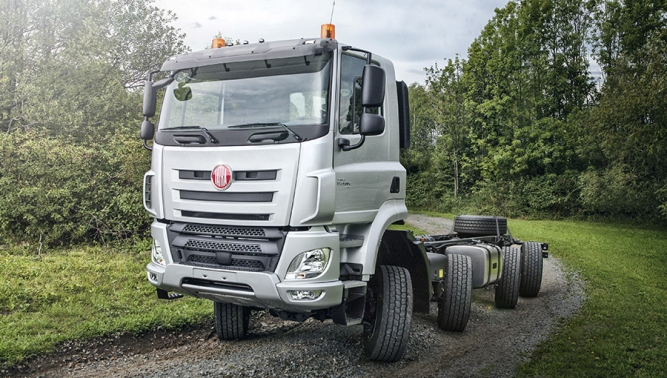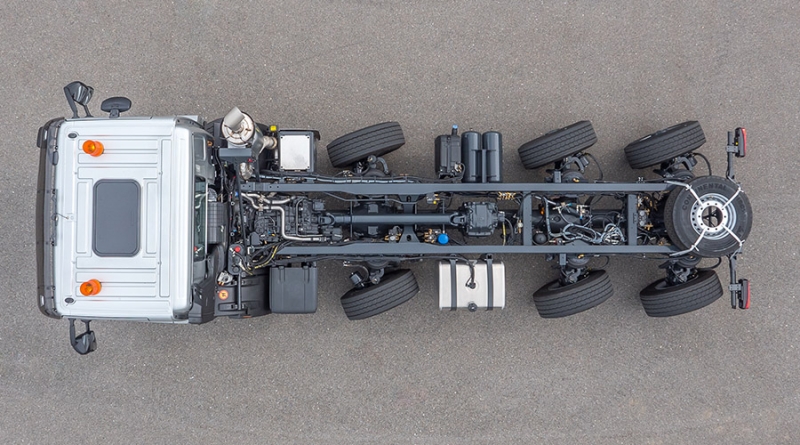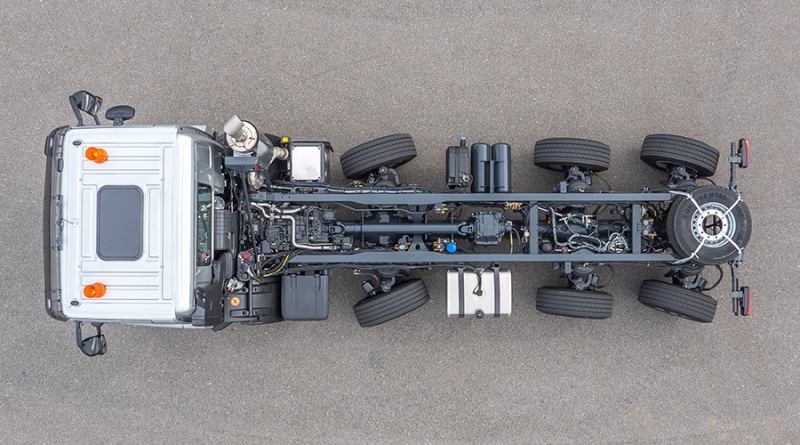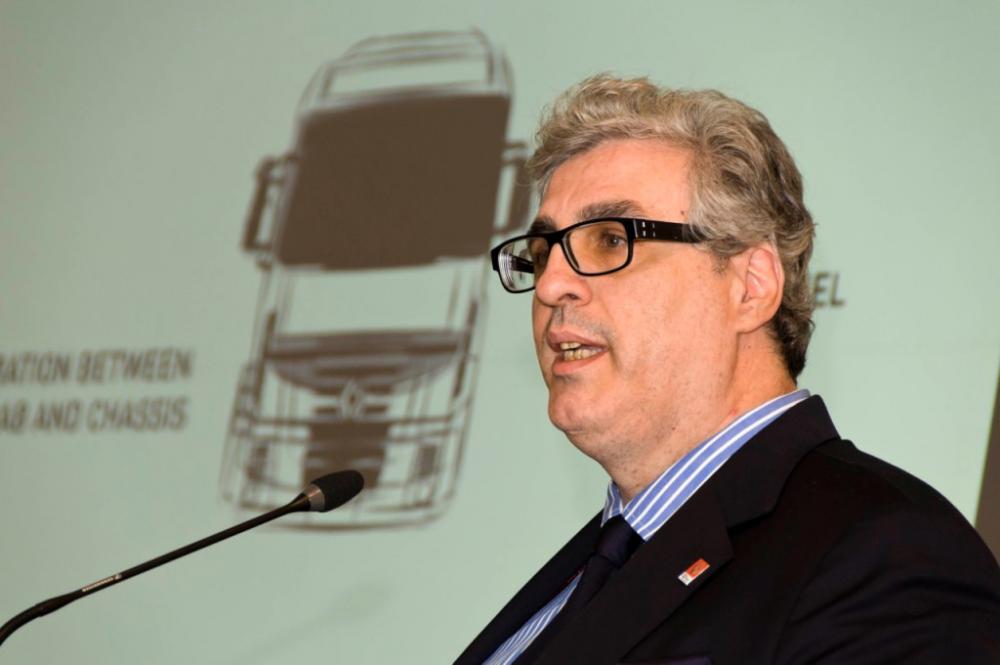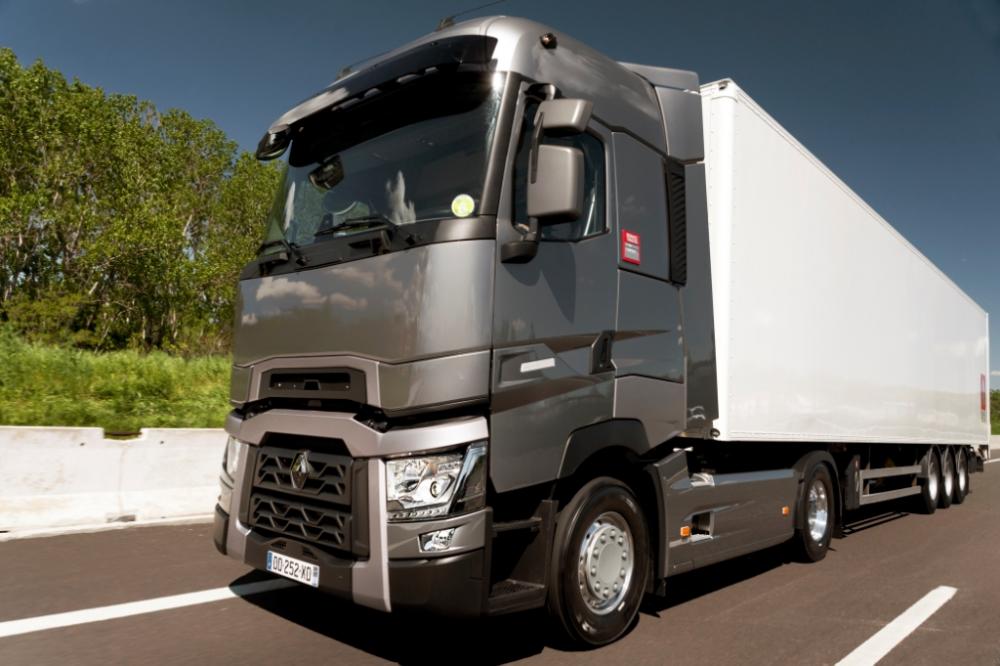
kscarbel2
Moderator-
Posts
18,855 -
Joined
-
Days Won
114
Content Type
Profiles
Forums
Gallery
Events
Blogs
BMT Wiki
Collections
Store
Everything posted by kscarbel2
-
DTNA Family at North American Commercial Vehicle Show
kscarbel2 replied to kscarbel2's topic in Trucking News
-
Hino to launch heavy trucks in North America
kscarbel2 replied to kscarbel2's topic in Trucking News
-
Hino to launch heavy trucks in North America
kscarbel2 replied to kscarbel2's topic in Trucking News
Yes. Their upcoming US market 6x4 will also be a Class 7/light class 8 like the Hino. But it will be an F-Series COE. -
New Benchmark of Success: New Ford F-Series Super Duty Limited Sets Bar for Luxury, Technology Ford Motor Co. Press Release / September 28, 2017 The F-450 Limited delivers technology and comfort previously reserved only in premium flagship sedans, and it’s capable enough to tow more than 30,000 lbs. Ford again establishes new top-end for trucks with the new Super Duty Limited, specially tailored for high-end heavy-duty truck customers – from boat captains to captains of industry Custom touches – inside and out – come standard on Limited, along with Super Duty capability and smart tech Ford continues offering a heavy-duty pickup truck for every customer – from work-ready F-250 XL starting at $32,890 to top-of-the-line F-450 Limited starting at $87,100 DALLAS, Sept. 28, 2017 – Ford – America’s truck leader – today pulls off the wraps of a new F-Series Super Duty Limited that sets new luxury standards for high-end heavy-duty truckers. With pricing at $87,100, the F-450 Limited delivers technology and comfort previously reserved only in premium flagship sedans, and it’s capable enough to tow more than 30,000 lbs. – about the weight of a stealthy Air Force F-35 fighter plane. “The Super Duty lineup is a win for all of our customers, from successful ranchers to contractors to RV owners,” said Todd Eckert, Ford Truck group marketing manager. “Super Duty Limited is the most luxurious and advanced heavy-duty pickup truck ever created by Ford for accomplished buyers, with appetites for the high life and hard-earned dollars to match.” Starting MSRPs (including $1,295 destination; taxes and fees not included) are: F-250 Super Duty Limited 4x4 $80,835 F-350 Super Duty Limited 4x4 $82,010 F-450 Super Duty Limited 4x4 $87,100 Customers who check every option box can top one out for as much as $94,455. What’s the point? “There are heavy-duty truck customers who need Super Duty-level capability and want true luxury,” Eckert said. “We created this new truck to answer the call for even more premium choices in the Super Duty range as we see more and more truck customers trending to more premium models.” More than 50 percent of the Super Duty lineup’s retail sales this year are high-end models – including Lariat, King Ranch and Platinum series. Limited goes even further. “Imagine opening the door to your humidor and sinking into your favorite leather lounge chair – that’s the sensation new Super Duty Limited inspires,” said Ford design manager Aileen Barraza. Custom Camelback two-tone leather seats, premium stitched leather-wrapped steering wheel, armrests and instrument panel, Miko® suede headliner, hand-finished dark ash wood trim, special badging set the interior apart. Outside, a special twin-bar satin grille with chrome accents, quad-beam LED lights and satin-finished tailgate applique are Limited’s unique calling cards. Each Limited also has a dedicated serial number laser-etched on the center console armrest. Most Super Duty tech ever Beyond the hand-crafting, Super Duty Limited comes standard with advanced and innovative features to get the job done on ranches, in marinas and everywhere in between. This includes: Class-exclusive high-definition 360-degree camera with Trailer Reverse Guidance Class-exclusive SYNC® 3 Class-exclusive BLIS® with trailer coverage Class-exclusive adaptive cruise control Class-exclusive adaptive steering Lane-keeping alert Forward collision warning with brake support Class-exclusive flat rear load floor with fold-up locking storage Class-exclusive quad-beam LED headlamps Full panoramic moonroof with retractable shade Heated and ventilated front seats, plus heated rear seats Leather-trimmed, heated steering wheel Is Ford backing away from heavy-duty truck buyers with fewer greenbacks? No way! Ford has a heavy-duty pickup truck for every customer – from work-ready F-250 XL starting at $32,890 to top-of-the-line F-450 Limited starting at $87,100. Super Duty Limited crew cab arrives this winter with Ford’s 6.7-liter Power Stroke® diesel V8 across F-250, F-350 and F-450 single- or dual-rear-wheel configurations. .
-
Green Car Congress / September 29, 2017 Cummins has been awarded a $47.4 million contract from the National Advanced Mobility Consortium (NAMC) to develop and demonstrate a technologically advanced engine for the next generation of US combat vehicles. The Advanced Combat Engine (ACE) project, led by Cummins Corporate Research and Technology and supported by Achates Power—the developer of next-generation two-stroke compression-ignition opposed-piston engines (earlier post)—aligns well with the research and development work of the US Army’s Tank Automotive Research, Development and Engineering Center (TARDEC). The goal of the project is to improve significantly the performance, survivability, and range of ground combat vehicles while reducing fleet fuel use. Cummins and Achates plan to reach these goals by reducing heat rejection by 21% compared to current Cummins-supplied combat vehicle engines. In addition, the project wants to improve power density by more than 50%, and reduce fuel use by 13% compared to current typical combat vehicle engines. This award builds upon 14 years of extensive development by Achates Power to modernize and optimize the opposed-piston engine. We are pleased to support Cummins on the Multi-Cylinder Advanced Combat Engine Technology Demonstrator program with our strengths in opposed-piston engine technology to deliver a superior engine for combat and tactical vehicles for the US Army. —David Johnson, CEO, Achates Power In March 2015, NAMC awarded Achates a $14-million project to support research and development work on the Single Cylinder Advanced Combat Engine Technology Demonstrator. Achates partnered with Cummins Inc. for that project, a precursor to the new award. (Earlier post.) The combat engine is a key part of the Army’s 30-year strategy to modernize tactical and combat vehicles, with potential for future configurations being used in the Bradley family of vehicles and the Next Generation Combat Vehicle. Related reading - https://www.bigmacktrucks.com/topic/19433-trucking-news-another-company-developing-fuel-efficient-opposed-piston-engine/?tab=comments#comment-358560
-
Kinedyne unveils Ioad-rated curtain-side system
kscarbel2 replied to kscarbel2's topic in Trucking News
. . -
Trailer-Body Builders / September 29, 2017 Cargo control specialist Kinedyne LLC used its press slot at the North American Commercial Vehicle Show to present a variety of new systems designed to address the demands placed on transportation providers by the impact of e-commerce on the supply chain. “E-commerce is creating new cargo challenges, and Kinedyne is delivering new cargo solutions,” Paul Wolford, vice president of sales and marketing for Kinedyne LLC, said. “In the beginning, e-commerce had the greatest disruptive effect on end-of-the-line, also known as ‘final-mile’ or ‘last-mile’ delivery activities, but now companies throughout the supply chain are looking for ways to minimize transportation costs for cargo as it moves more swiftly throughout multiple transportation modes.” Among the products introduced were a load-rated curtain-side system and a unique double-decking system designed specifically for curtain-side applications. The lightweight curtain-side system opens and closes at lightning-fast speeds, but is engineered to restrain lateral cargo movement. A load-rated curtain gives a trailer the combined advantages of flatbed access and a van’s walled structure. The double-decking system maximizes load density, allowing loading and unloading access of both cargo levels from the sides and rear, and all of its components conveniently stow in the trailer to avoid loss or damage. “Popular in Europe, load-rated curtains become part of a vehicle’s overall load securement system. They save time, weight and fuel, while providing sideways restraint to otherwise fully secured loads up to the curtain’s stated rating,” Wolford said. “Our rated curtains will display their load rating as either allowable weight per pallet width, allowable weight per pallet space or total payload of evenly distributed pallets across the entire deck space. Forward and rear cargo restraint must still be provided by headboards, tailboards and other traditional load securement methods.” During his presentation, Wolford highlighted the following related products: Load-Rated Curtain-Side System: The industry’s first load-rated curtain-wall system with a reinforced structural profile. The system is suitable for trailers up to 53 feet. With rapid access on both ends, the cargo space can be opened and closed again within seconds. The lightweight system is adaptable to a number of logistical challenges, such as palletized cargo, double-decking, rack-mounted goods and the transport of beverages. Double-Decking System for Curtain-Side Applications: This unique double-decking system enables users to optimize the cargo capacity of Kinedyne’s advanced load-rated curtain-side system. The system accommodates cargo of varying dimensions and heights. System configurations can support between 13,000 and 24,000 pounds on their second loading levels. Fast-Access Curtain-Side System for the Urban Core: This curtain-side system was specially developed for fast and repetitive city distribution and short truck bodies of up to 28 feet. It’s ideal for side loading and unloading in busy city centers. The cargo space can be opened, accessed from both sides and closed again within seconds. This system can be combined with a sliding roof and rear doors, creating a totally open cargo access environment. Quick-Release Curtain-Side System for Standard and Tapered Bodies: The flexible quick-release latching system is particularly well suited for truck bodies that are tapered at their top. Skewed body construction often occurs when unique cargo must be accommodated, such as beverage and glass truck applications. This ergonomic system replaces cumbersome buckle closures and heavy roll-up doors that require stretching and straining to close. Patented Ultra-Smooth Sliding Roof System: This unique sliding roof system has patented folding plates and can be paired with an extended range of aluminum rails or combined with other curtain-style rapid-access products. The sliding roof makes the loading and unloading of long cargo easy and convenient and allows the use of over-head cranes. Users can choose between a traditional rear-to-front sliding roof or a sliding roof that opens and closes at both ends. Special patented security accessories are also available. Patented Non-Binding Roller Technology: All curtain-side and retractable roofs are equipped with advanced, patented roller technology that makes opening and closing them faster, safer and less ergonomically challenging. The three-roller design includes a steel horizontal roller that ensures effortless sliding and prevents the curtain from binding even when being briskly opened and closed. To bring these new technologies to North America, Kinedyne tapped the resources of its sister company, Wistra Cargo Control, and one of its European suppliers, Versus-Omega. Both organizations are well respected and their technologies continue to set trends within the European Economic Community and globally. All products are expected to be commercially available by January 2018. .
-
Hino to launch heavy trucks in North America
kscarbel2 replied to kscarbel2's topic in Trucking News
My first thought is, since Hino has made such a great effort to reinvent themselves in the North American market as a conventional truck manufacturer, these new trucks will be conventionals based on the 500 Series. The COE Hino FF and FG trucks sold in the US during the 1980s, imported via Jacksonville, Florida, were superb trucks. But Hino didn't get any traction until they introduced conventionals in 2003. Now they're a success story, while UD abandoned the US market in 2012 (Volvo's decision). Of course at Mack we introduced the conventional "CS" series Mid-Liner, and sold a lot. But I sold more "MS" COE Mid-Liners that CS's. -
Volvo introduces new Mack “Anthem” on-highway tractor
kscarbel2 replied to kscarbel2's topic in Trucking News
Scenes and notes: Out on the road with Mack's new top dog Aaron Marsh, Fleet Owner / September 28, 2017 Mack Trucks showed off its new Anthem tractor at the North American Commercial Vehicle Show this week in Atlanta. But those trucks had to get there somehow, didn't they. Fleet Owner joined in that expedition; join us for another look. Out on the road with the 10-truck convoy bringing Anthems and a few other trucks to display, there was more to notice about Mack's latest highway hauler. One thing is that taking some time to get to know the truck's controls — and those of the systems on it — will make you glad you did or frustrated you didn't. We'll also say the truck's appearance works as designed: it gets looks, and from more than just the trucking crowd. Out in the Anthem, we got thumbs-ups and plenty of interest from people driving by, sometimes with a passenger leaning out the window with a phone to take a photo of the brawny-looking Macks. Other truck drivers in Macks, of course, also showed their camaraderie. More than a few air horns sounded as older Macks crossed paths with the Anthem on the highway. Check out some photos and notes from hundreds of miles on the road from Allentown, PA to Atlanta. Photo gallery - http://fleetowner.com/trucks/scenes-and-notes-out-road-macks-new-top-dog#slide-0-field_images-227491 -
Fleet Owner / September 29, 2017 While a host of safety and semi-automation systems available to fleets, getting it implemented correctly is the critical issue, not the technology itself, component and system supplier argues. If there is one lesson the trucking industry should take away from the Tesla car crash last year that occurred when the vehicle was on autopilot, it’s that technology itself might not be the issue – it is how technology gets implemented and ultimately used on a day-to-day basis. That’s the line of thought Fred Andersky, director of customer solutions for the controls group at Bendix Commercial Vehicle Systems LLC put forth during a press conference at the North American Commercial Vehicle (NACV) show this week. “The Tesla crash shows that it’s not the technology that is necessarily the concern; it’s the issue of implementing technology,” he explained. The National Transportation Safety Board determined that a truck driver’s failure to yield the right of way and a car driver’s inattention due to overreliance on vehicle automation were the probable cause of the fatal Tesla crash back in May 2016, near Williston, FL. The NTSB also determined the operational design of the Tesla’s vehicle automation permitted “over-reliance” on the automation technology allowing for “prolonged disengagement” from the task of driving a vehicle and also enabled the Tesla owner to use the technology in ways “inconsistent” with manufacturer guidance and warnings. “System safeguards, that should have prevented the Tesla’s driver from using the car’s automation system on certain roadways, were lacking and the combined effects of human error and the lack of sufficient system safeguards resulted in a fatal collision that should not have happened,” noted NTSB Chairman Robert Sumwalt III in a report two weeks ago. Technology like Tesla’s ‘Autopilot’ system “are designed to assist drivers with specific tasks in limited environments,” he stressed. “These systems require the driver to pay attention all the time and to be able to take over immediately when something goes wrong.” At the NACV briefing, Andersky noted that “autonomy encompasses a number of factors, including the appropriate use, understanding, and implementation of the technology, along with the wider impact of the ecosystem surrounding the application.” But he added that development of autonomous technology will continue to be encouraged, especially in cars and especially by government agencies like the National Highway Transportation Safety Administration (NHTSA). “Their basic role is to reduce crashes and save lives and they see a much bigger fish to fry in terms of autonomous cars versus trucks,” he added. “That’s why they are more focused on that [car] side. But there is value for truckers here as cars are the ones crashing into them.” A University of Michigan Transportation Research Institute (UMTRI study conducted several years ago showed assigned car drivers “factors of fault” in 81% of the car-truck crashes studied, compared with 27% of truckers. Those totals were greater than 100%, UMTRI said, because 10% of crashes assigned blame to both car and truck drivers. Also from the UMTRI study: Cars were the encroaching vehicle in 89% of head-on crashes; in 88% of opposite-direction sideswipes; in 80% of rear-end crashes and in 72% of same-direction side-swipes, which it said were “obvious indicators of fault.” Andersky also highlighted another key issue where truck technology implementation is concerned: calculating and acting on its benefits. “Fleets are really just now starting to understand the safety performance benefits and lower total cost of operations (TCO) possible with new technologies,” he explained. For example, brakes remain the top reason why trucks are placed out of service during the annual 72-hour Roadcheck International safety inspection blitz, representing 26.9 % of all vehicle out-of-service violations. Many of those are due to traditional drum brakes being “out of adjustment,” which is a problem that would be solved by switching over to air disc brakes. Yet maximize a return on investment due to the higher cost of air disc brakes versus drum brakes, fleets might want to revisit their highay tractor trade cycles, Andersky explained. “They might move from a typical three year trade cycle – which they may use in part to avoid major drum brake work – and expand to a four or five year cycle to gain the full [TCO] benefit of air disc brakes,” he said. Berend Bracht, Bendix’s president and CEO, noted during the press conference that air disc brakes are a “building block” where autonomous vehicles are concerned and will “likely one day” be a mandated requirement. Aside from the technology discussion, Bendix highlighted several product enhancements and other endeavors: Bendix Spicer Foundation Brake LLC – a joint venture between Bendix and Dana Commercial Vehicle Products – added a new air disc brake (ADB) production line at its wheel-end manufacturing operation in Bowling Green, KY, which became fully operational early this month and will be ramping up to full capacity through the end of the year. Bendix noted that more than 20% of North American Class 6-8 trucks with air-brake wheel-ends are now equipped with ADBs; a 50% increase in overall market share since 2013 Bendix is offering a new ADB value calculator, available at ValuebyBendix.com, to help fleets understand what the potential savings might be if they spec ADBs on all wheel positions of their tractors and trailers; Bendix is also rolling out “next-generation” drum brakes as a factory-installed option at all major North American medium- and heavy-duty truck manufacturers; brakes that offer weight savings up to 16 lbs. per tandem axle set as they’ve been converted from a “cast spider” to a “heavy-duty stamped spider” design. Ford Motor Co. is going to make the Bendix ESP (short for ‘electronic stability program’) electronic stability control package a standard feature on all 2018 model year F-650 and F-750 tractors, plus as an option on certain F-750 straight truck configurations. Fleet trials of Bendix’s new Intellipark automatic parking brake system will begin in 2018; a technology designed to help drivers prevent rollaway and runaway crashes caused by an improperly set or disengaged parking brake. It will replace manual air system-based parking brakes with electronic switches. It’s also designed to work on any air-braked vehicle, including tractor-trailers, single-unit trucks, motor coaches, and school buses. The company is updating its BlindSpotter Side Object Detection System with a new and “more effective radar unit” that can be integrated into its Wingman Fusion advanced driver assistance technology. Using a passenger side-mounted radar unit, BlindSpotter is designed to alert drivers to vehicles or objects in adjacent lanes. The new version will offer the same look, size, position, and mounting hardware for the radar and in-cab display units but with a significantly wider “field of view,” allowing it to “see” farther toward both the front and back of the combination or single-unit vehicle. It will be available in the first quarter of next year. Also in 2018 Bendix said it will offer upgrades to its Wingman Fusion system to include highway departure braking and multi-lane automatic emergency braking, along with strengthened collision mitigation capabilities via the use of automatic braking. Those new options come through software advancements, meaning current Fusion customers will be able to upgrade to the new capabilities with no need to purchase new hardware components. Bendix plans to begin demonstrating the new upgrades prior to the close of 2017 and throughout 2018. Bendix will begin offering a new aftermarket heavy-duty drum brake friction pad to help keep their vehicles compliant with reduced stopping distance (RSD) requirements of 250-ft. called the BA232R in early October. It’s designed to handle heavy line haul, heavy pick-up and delivery, severe duty, and refuse applications. In testing, Bendix said its BA232R lining provided an average 235-ft. worth of stopping distance –exceeding the RSD mandate. Bendix is also launching a new spring brake line called EnduraSure, which includes an improved version of its standard chamber and is already in production. EnduraSure will replace the EverSure spring brake family. In a personnel note, Bendix recently appointed Stephen “Steve” Daukaus to be its vice president of finance and information technology as well as its chief financial officer. Daukaus, who joined Bendix on Sept. 5, also became the newest member of the Bendix Leadership Committee. He fills the position held previously by Arnfred Kulenkampff, who will be retiring at the close of 2017.
-
New Class 4, 5 Silverados on the way from Chevrolet Fleet Owner / September 29, 2017 Medium-duty Silverado trucks to be 'powerful, maneuverable, easy to upfit' This week at the Texas State Fair, Chevrolet said it is launching new Class 4 and 5 trucks "late next year" that will be branded Silverado. The announcement came as part of Chevy's Centennial Truck event celebrating a century of Chevrolet pickups. Chevy pointed to its truck activity over the last three years, including the introduction of a redesigned 6.6L Duramax diesel for heavy-duty pickups. The forthcoming Silverado 4500 and 5500 models will all be powered by a Duramax diesel engine and have an Allison automatic transmission. Based in Indianapolis, Allison is the largest manufacturer of medium- and heavy-duty fully automatic transmissions that have been used in applications including construction, fire, distribution, defense, energy and refuse trucks. Allison transmissions have also been found in Chevy trucks since the 1950s. "The Silverado 4500 and 5500 will stand out because we've designed the trucks around how customers work," said John Schwegman, U.S. director of commercial product for Chevrolet. "They will be powerful, highly maneuverable and among the easiest trucks on the market to upfit with specialized bodies such as dump bodies, rollbacks, freight boxes and more." Both the Silverado 4500 and 5500 will be available in Regular and Crew Cab models, with 4x2 and 4x4 capability and a range of gross vehicle weight ratings and wheelbases. The trucks will be offered with optional OnStar with 4G LTE connectivity provided by AT&T, which Chevrolet noted fleet management companies are embracing to help improve safety and productivity. Chevrolet noted it would release full technical specs for the new Silverado 4500 and 5500 "close to launch." The OEM also said its commercial sales are up by 48% since 2013, and domestic segment share has grown year-over-year for the past 13 consecutive months. "We are earning new business because we have more solutions to help businesses grow," Schwegman said.
-
VW boosts 2018 warranties to 6 years/72,000 miles Automotive News / September 29, 2017 DETROIT -- Volkswagen, seeking to speed its recovery from a diesel emissions cheating scandal, will offer a lineup of 2018 cars and crossovers in the U.S. with expanded warranties that are twice the duration of those at most competitors. The expansion to a six-year/72,000-mile bumper-to-bumper transferable warranty for each car and crossover in the brand's 2018 U.S. lineup -- except the battery electric e-Golf -- brings VW's other vehicle warranties in line with those of the newly launched 2018 Tiguan and Atlas crossovers. In April, VW said it planned to introduce the Atlas and three-row Tiguan with the expanded warranty to boost customer confidence in the brand as it entered new segments in the U.S. Unlike most competitors, Volkswagen's "People First" warranty is transferable to subsequent owners for up to six years from the date of the vehicle's original purchase or 72,000 miles. The plug-in electric Volkswagen e-Golf, the one model exempt from the new warranty, will retain traditional three-year/36,000-mile bumper-to-bumper coverage, with powertrain components warrantied for five years/60,000 miles. The e-Golf's battery pack also carries its own warranty covering loss of more than 30 percent of its charging capacity for up to eight years/100,000 miles, Volkswagen said in a statement Friday. The move to offer expanded warranties that are double the industry standard three-year/36,000-mile bumper-to-bumper is likely to give Volkswagen -- which has a car-centric lineup in the U.S. -- an edge against competitors amid waning consumer interest in traditional sedans, coupes and hatchbacks. It also comes as the brand attempts to restore market share -- and its reputation -- from the fallout of diesel emissions violations. The VW brand's U.S. sales skidded 12 consecutive months starting in Nov. 2015 after the company acknowledged skirting U.S. diesel emissions rules. The brand's U.S. sales have risen 6.4 percent in 2017 to 220,344 through August, while the overall market is on pace to decline for the first time after seven straight years of gains. Analysts applauded VW's expanded warranty coverage. “It’s an excellent move for them,” said Finbarr O’Neill, president of J.D. Power and Associates. In 1998, early in his tenure as CEO of Hyundai Motor America, O’Neill instituted a five-year bumper-to-bumper/10-year powertrain warranty called the Hyundai Advantage. At the time, Hyundai was battling a reputation for poor quality. Within four years, Hyundai U.S. sales more than quadrupled. “This is less about the diesel crisis and more about removing any reservations that consumers might have” about buying a VW, O’Neill told Automotive News. “Essentially, they are putting their money where their mouth is, and consumers like that.” Michelle Krebs, executive analyst for Autotrader, said the expanded warranty is also an important tool to help consumers address new-vehicle affordability. "To keep monthly payments down, consumers are stretching auto loan terms," said Krebs. "The Volkswagen warranty extends along with those loans to help the first buyer -- and even the second buyer of a VW -- save repair costs.” Rebuilding block Hinrich Woebcken, CEO of Volkswagen Group of America, said the expanded warranty will play a key role in helping rebuild the VW brand. “Our future success depends on how well we listen and respond to our customers to rebuild their love for Volkswagen,” Woebcken said during a press briefing at a dealership in Dearborn, Mich., on Friday. Woebcken said the VW brand was at a “fundamental turning point” and laid out several goals for 2018 that include “rebuilding the trust of our customers, dealers, and employees." Michael DiFeo, chairman of the Volkswagen National Dealer Advisory Council and dealer principal of Linden Volkswagen in Roselle, N.J., said he and other VW dealers have already seen the impacts of the expanded warranty offerings on consumers in their consideration of the Atlas and, more recently, the three-row Tiguan. "Having a best-in-class warranty is impacting their buying decisions," DiFeo said. Bringing the expanded warranty to the remainder of the lineup can only help sell vehicles, he said. "The perceived cost of ownership of a Volkswagen has always been one of the reasons why people have not considered the brand, and I think having the [six-year/72,000-mile] warranty addresses that concern head-on," DiFeo said. As for Volkswagen dealerships, the additional warranty "will be beneficial for our service departments. Over time, we should see an increase in consumer business," DiFeo said.
-
Prime Mover Magazine / September 28, 2017 Commercial vehicle manufacturer, Daimler Truck and Bus, has announced that it has separated from Mercedes-Benz car and van divisions in Australia. Formerly part of Mercedes-Benz Australia Pacific, Daimler Truck and Bus will now be its own truck and bus business. Changes in the structure of Daimler group in Australia are seen as more than just administrative streamlining, according to Daimler Truck and Bus Head – Truck and Bus Division, Daniel Whitehead. “Daimler Truck and Bus, Mercedes-Benz cars and Mercedes-Benz vans have been operating as separate divisions in Australia since 2014 but the latest phase of the Customer Dedication process means that the three divisions will function as separate legal entities from October 1 as part of a global Daimler strategy,” said Whitehead. Whitehead's title will change from Managing Director to President and CEO of Daimler Truck and Bus Australia, and he reportedly regards the change in structure as an opportunity to deliver benefits to the company’s customers. “This is a great development for our company,” he said. “We are now a fully dedicated truck and bus company. It will enable Daimler Truck and Bus to intensify our focus on our customers who have very different needs to van and car customers. It will give us increased flexibility and enhance our ability to better respond to customer needs as we pursue our growth strategies.” .
-
Prime Mover Magazine / September 28, 2017 Tasmania-based family business, De Bruyn Transport, has added five new Mack Granites to its 110 vehicle-strong fleet. According to Mack, the new Granites are set up as pneumatic tankers, hauling stockfeed, cement and lime, across Tasmania. According to Managing Director, John de Bruyn explains, tare weight is a major consideration when running tankers. “Our loads are measured and paid for by the kilo, so every bit counts,” said De Bruyn. "We have to set our tankers up to get the maximum gross mass on the vehicle. “Normally with a bonneted truck it’s hard to get the turntable in the correct position. With the Front Underrun Protection System in place you can get 6.5 tonne on the steer axle, but to do that you need to move the turntable right forward. Some trucks don’t cope with that too well, but we can do this with the Granite and be confident that truck will handle the roads we have down here.” Over the last few years, De Bruyn has been gradually replacing the trucks in the fleet with Macks, Volvos and UDs. “Everything we’ve bought in the last few years has been one of those three brands through Websters," De Bruyn said. "Each of the brands offers trucks that have a specific role to play in our fleet, but we do a lot of our own servicing, so commonality across the trucks is important. “Obviously there are differences, but there are lots of similarities between Macks and Volvos now. From a parts and service perspective, and purely for familiarity, it’s a lot easier to have all our trucks from the same group. It also means we can deal with the same people and get a consistent level of support.” .
-
New International HV Series truck launch in US Prime Mover Magazine / September 28, 2017 Commercial heavy vehicle manufacturer, International Trucks, has launched its HV Series truck at the North American Commercial Vehicle Show, boasting uptime enhancements and advanced integration options for body builders. "The new International HV Series is just one more truck in our product line-up that puts drivers first and meets the gruelling demands of vocational applications," said International President – Trucks and Parts, Michael Cancelliere. "The HV Series is a smart solution for our customers in the business of doing serious work and is a new breed of vocational truck that redefines the standard for uptime and productivity. It is the go-to truck for those who know that it's not just about getting the job done, it is about getting it done right." According to International, the HV Series interior was crafted with driver and body company feedback to ensure the most comfortable and productive environment possible. “The HV Series also features the intelligence of the industry-leading Diamond Logic electrical system for the automation of tasks and interlocks to help protect both equipment and crew,” the company said. “The truck offers customers an incredibly versatile foundation for any configuration necessary to be productive at any job and includes power options like the International A26, an engine designed with uptime in its DNA.” International has said that the HV Series features a heavy duty, double-sided galvanised steel cab for long-term durability, Huck bolt chassis fasteners to provide superior clamping in extreme environments as well as a clean Cab-to-Axle (CA) configuration to reportedly minimise costly part production and modifications. The manufacturer has said that the HV Series is powered by the 12.4L International A26 engine, which is designed to provide industry-leading uptime, greater fuel efficiency and quieter operation. Built from the MAN D26 engine crankcase, the A26 can reportedly produce up to 475 horsepower and 1,700 lb.-ft. of torque from a design that is 600-700 lbs. lighter than a traditional 15L big bore engine. “The A26 is also backed by the industry's best warranty and is the first engine to meet the B10 standard that requires 90 per cent of delivered engines to travel 1.9 million kilometres before a major repair,” according to International. “HV Series is also available with the Cummins B6.7 and Cummins L9 engines.” The HV Series will feature a remote diagnostic option called OnCommand Connection with Over-the-air (OTA) programming. OTA, available through the nine-pin International LINK device, will reportedly enable drivers and fleet managers to use a mobile interface to initiate authorised engine programming via a Wi-Fi connection. The service will offer drivers and fleets the means to update engine control modules to reflect the latest manufacturer-approved calibrations, without needing to visit a dealer or service facility. According to International, the HV Series has an advanced electrical system that can streamline chassis and body integration, allowing program-automated tasks. "Our Diamond Logic electrical system is best known for its ability to provide control and communication between work trucks and body equipment," said International Vice President – Vocational Truck Business, Mark Stasell. "We are a pioneer in custom programmable chassis electronics and multiplexing and we continue to partner with end users and body builders to further increase productivity and make it easy to integrate with our system." .
-
Truck journalist Iep van der Meer / April 13, 2017 .
-
New Zealand seeks to recruit 1,000 Irish truck drivers
kscarbel2 replied to kscarbel2's topic in Trucking News
Irish truck drivers encouraged to keep on trucking ... to New Zealand Wednesday, September 27, 2017 - 10:19 pm With an estimated shortage of more than 1000 truck drivers in New Zealand a new relocation package has been developed to attract heavy vehicle drivers from Ireland. The package will see processing costs for successful applicants and their families waived and further relocation assistance provided in a bid to attract drivers to the country. The Managing Director of Canstaff, Matt Jones, operates a number of globally recognised recruitment companies and working with immigration services identified that recruiting overseas drivers was the only way to fill the shortage gap. “We realised how dire the shortage was when we could physically see the number of trucks parked up and out of use due to the lack of drivers. Despite Government initiatives to attract more heavy vehicle drivers, the shortage has been ongoing and a more immediate solution is needed to keep New Zealand’s wheels of commerce turning.” With the average age of a truck driver being 57 years of age the situation has reached a critical stage with employers turning to global recruitment companies like Canstaff to source overseas candidates. Although the driver shortage is an ongoing struggle for employers, it has opened up some impressive incentives for international candidates, says Jones. “The incentive here for overseas drivers is not only the relaxed Kiwi lifestyle, we can also offer top dollar wages and guaranteed shifts with more available if required. Salaries have increased 20% in recent efforts to attract more people into the industry and we are confident that our relocation package surpasses any other currently on offer.” Applicants are required to have a class five licence or equivalent to operate a heavy combination truck and trailer unit up to 25,000 kgs GCW, two years experience, and be eligible for a visa. Canstaff will assist with, and submit all necessary paperwork to get successful applicants’ journey to New Zealand underway and add-ons to the relocation packages are available to some candidates. “We basically take all of the stress out the move and arrange everything for our applicants. All they need to do is apply and our specialist staff will guide them every step of the way,” explained Jones. For more information on relocating to New Zealand visit canstaff.co.nz or email jobs@canstaff.co.nz. -
The Irish Times / September 27, 2017 Irish long distance drivers are being invited to travel a very long distance to get work. New Zealand is looking to recruit up to 1,000 truck drivers from overseas as it cannot fill the vacancies internally. It takes three years to qualify as a heavy goods vehicle (HGV) driver in New Zealand and many young Kiwis are not attracted to the job. Recruitment firm Canstaff is offering a new relocation package to overseas heavy goods vehicle (HGV) drivers from Ireland to fill the skills shortage. In some cases haulage companies will pay the cost of flights to New Zealand. Irish truck drivers can earn between €15 and €20 an hour in New Zealand. In Ireland the rate is closer to €12 an hour, according to Canstaff managing director Matt Jones. Mr Jones said he had spent a lot of time in Ireland in 2011 and 2012 recruiting construction workers to rebuild Christchurch which had been badly damaged in an earthquake. “When I was there recruiting in 2011 and 2012 there was no jobs in Ireland. Clearly the economy has improved. This is about coming to have an experience of New Zealand. You are going to make more money than a truck driver in Ireland. “Ideally it would be single fellows rather than those who want to relocate with their families. The biggest thing in New Zealand is finding your way around. Google maps is only so good and it’s not always right.” The average reported salary for a New Zealand truck driver last year was NZ$51,200 (€31,000), but wages have gone up by 20 per cent to attract the right candidates. “We realised how dire the shortage was when we could physically see the number of trucks parked up and out of use due to the lack of drivers,” Mr Jones added. “Despite Government initiatives to attract more heavy vehicle drivers, the shortage has been ongoing and a more immediate solution is needed to keep New Zealand’s wheels of commerce turning.” He said Irish drivers would be attracted by the “relaxed Kiwi lifestyle”, guaranteed shifts and “top dollar wages”. Applicants are required to have a class five licence or equivalent to operate a heavy combination truck and trailer unit up to 25,000 kgs GCW, two years experience, and be eligible for a visa. Canstaff is also bringing 70 New Zealand dairy workers to Ireland to work on Irish farms. In June next year 70 Irish dairy workers will work in New Zealand.
-
Hino to launch heavy trucks in North America
kscarbel2 replied to kscarbel2's topic in Trucking News
Hino Motors Announces $100-mil Investment, 250 New Jobs TriState Update WOWK / September 27, 2017 Millions of dollars invested and hundreds of new jobs are coming to Wood County as Hino Motors will take over the nearly 1,000,000 square-foot Coldwater Creek Site and convert it to a truck production plant. Hino Motors has called Williamstown home for 10 years, but production has increased 500 percent. The company has outgrown it's current facility, so Hino is relocating to a bigger and better site,adding several hundred employees to the growing company. Senior Vice President at Hino Motors, Steve Stalnaker, says, "In the 10 years that Hino has been in business here, team members again and again have demonstrated they've risen to the challenge of producing world class trucks." Hino officials say it was an easy decision to pick the old Coldwater site, it is just a few miles from the current Williamstown plant. "What was really important to us to be able to maintain our team members. So the fact that we're just about 20 minutes away from Williamstown, is a huge bonus for us, that we can potentially move all our team members to a new facility," said Executive Vice President at Hino Motors, Davey Jung. Hino will take over the 60 acres Coldwater Creek sits on, 20 acres to the side, and 35 acres in the back to combine and streamline operations. The company will bring over its 300 Williamstown employees, and add 250 additional jobs. West Virginia Commerce Secretary Woody Thrasher said, "I think things like this and the Toyota announcement that happened yesterday speak volumes about the quality of workforce that we have, the training, the commitment, and the real craftsmanship that's needed in the automotive industry. We still raise and train significant craftspeople in the state of West Virginia." Hino is also working to purchase more raw materials locally.. supporting the mountain state economy. "We currently have a lot of parts still coming from Japan, and so we're making a lot of effort to localize these parts. And with this effort we're hoping we can add some West Virginia manufacturers to our supply base," said Jung Hino says it still hasn't made a decision as to what will happen to the current Williamstown facility. The company hopes to have the mineral wells truck assembly plant up and running by early 2019. . -
Czech truckmaker Tatra has introduced a new configuration that could be described as an 8x8x8. The four-axle truck not only has four driven axles, but they are all steerable as well. The truck was specially engineered for a Swiss customer that will equip it with a heavy crane. With all wheels steering in all directions, the truck can reach even the narrowest places for special jobs. .
-
Volvo introduces new Mack “Anthem” on-highway tractor
kscarbel2 replied to kscarbel2's topic in Trucking News
The Mack brand “Anthem” was designed by Renault Trucks’ Design Director Hervé Bertrand, who designed the Renault Range T. . -
DTNA Family at North American Commercial Vehicle Show
kscarbel2 replied to kscarbel2's topic in Trucking News
. . -
Chevy Celebrates 100 Years of Iconic Truck Design General Motors Press Release / September 28, 2017 DALLAS — One hundred years ago, Chevrolet introduced the 1918 One-Ton, setting the stage for a century of iconic trucks. To commemorate this milestone, the brand is looking back on 10 of the most iconic designs in Chevy truck history. While Chevrolet truck design has changed radically over the past 100 years, one thing has always been true: Form has followed function as the trucks evolved to meet the customers’ changing needs. “Today, the Chevrolet truck design studio is focused on purposeful design that creates personality and customization options for a wide breadth of truck customers,” said Rich Scheer, director of Exterior Design for Chevy Trucks. “Looking back on the past century of truck design, I realized that Chevrolet designers have been focused on the same goals since the very beginning.” Here are 10 of the most iconic Chevy trucks in the past 100 years, along with a design perspective for each from Scheer: 1918 One-Ton: The first production truck from Chevrolet was inspired by vehicles used in plants to move parts and pieces from place to place. In the simplest terms, this is an example of form follows function. It was a rolling chassis featuring an open cab, an inline four-cylinder engine and an open frame allowing customers to install the body that fit their unique needs. One striking design element is the beautiful badge, which was clearly a designed element of this truck. The font, the proportions and the dark blue, almost black color make a very sophisticated bowtie, even by today’s standards. 1929 International Series LD: The 1929 was the first Chevrolet truck to feature a closed cab, which created the potential for what we know as interior design today. As with all designs, once the functional elements were defined, more comfort- and style-focused features started to become important for truck buyers. It’s amazing how fast they went from the purpose-built 1918 truck to a more styled, closed-cab truck. This is also the time when we started to introduce color. The color combinations on Chevrolet cars and trucks from this period are something I still love today. 1938 Half-Ton: This was the first truck designed in the newly formed Art and Colour department, which was later to be known as Design Center, by Harley Earl and his team. (Earl became GM’s first design chief.) This year also saw the designs of cars and trucks deviate, as Design realized the need for trucks to have their own identity. As such, it is arguably the first example of Design’s influence on trucks. The proportions really evolved from the earlier designs, creating a lower and longer truck with a styled grille and elegant, swept fenders. 1947 3100 Series: This is one of the most iconic designs in automotive history. If you mention a vintage Chevy truck, I think almost everyone will picture this model in their mind. It was such a departure, advertisers coined the phrase “Advance Design,” because it was bigger, stronger and sleeker than ever before. The five-bar horizontal grille is a departure from vertical grilles of the past and was the very beginning of what became a signature of Chevrolet truck design. You can see that the fenders are more integrated and the lamps are on the wide part of the vehicle instead of inboard, giving it a wider, stronger presence. The result is very handsome design with great proportions. 1955 3124 Series Cameo Carrier: Known as the Task Force truck, the Cameo Carrier is Chevy’s first Fleetside design. The bed surface is flush with the cab and fender, making for one complete, elegant shape from front to back. It was also Chevrolet’s first bumper-to-bumper styled truck, as styling didn’t stop at the back of the cab. During this time, styling became a selling point for cars, inspiring more focus on design for trucks as well. This was definitely the heyday of American automotive styling and ornamentation. 1967 C10 Fleetside: This is the first truck that I really fell in love with. It’s a beautiful, sleek design with a hint of wheel flare. I also really appreciate the line that flows away from the top of the bed line and the beautiful balance with the front of the vehicle. This is a feature that can easily go wrong, but the designers of the time did it so right. The body side has a strong shoulder that tapers toward the rear. The Chevrolet bar on the front fascia connects the headlamp center with the bowtie — a design element that is still consistent today. This time period is also when metallic paint was introduced, which highlighted the subtleties and body lines that weren’t as obvious before. 1973 C30 One-Ton Dually: This third-generation C/K square-body truck was the first crew cab dually to market, and many consider it to be the first modern Heavy Duty Truck. The design reflects a dramatic increase in capability for customers who used their trucks for both work and recreation. It is simple, tough and purposeful, similar to the earliest Chevrolet trucks. 1988 C/K1500: The C/K1500 was the first truck design influenced by aerodynamics. This generation had great design reach, meaning it looked very advanced for its time. That is especially true for the new interior design, with a low instrument panel, pod-like setup and even buttons that looked futuristic. This truck still looks modern and sophisticated 40 years later. 1999 Silverado 1500 LT Z71: This was the first generation that used the Silverado nameplate. It also introduced many of the modern design elements that customers associate with current Chevy truck design, especially the iconic Chevrolet front end. 2007 Silverado 1500: The 2007 Silverado is simple, modern and powerful, featuring exaggerated wheel flares and a clean body side. It’s another evolution for Chevrolet trucks in creating their own identity on the road, with distinctive front and rear ends. This truck brought back the “tough truck” look and feel, even though it was still heavily influenced by aerodynamics. .
BigMackTrucks.com
BigMackTrucks.com is a support forum for antique, classic and modern Mack Trucks! The forum is owned and maintained by Watt's Truck Center, Inc. an independent, full service Mack dealer. The forums are not affiliated with Mack Trucks, Inc.
Our Vendors and Advertisers
Thank you for your support!


